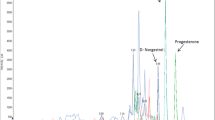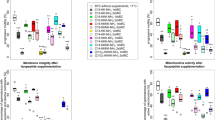Abstract
The presence of proteolytic enzymes in urine samples, coming from exogenous or endogenous sources, enhances the cleavage of human chorionic gonadotropin (hCG). Moreover, elevated temperatures occurring occasionally during the delayed transportation of sport urine samples, favor the nicking of the hCG molecule. The aim of the current study, funded by the World Anti-Doping Agency (WADA), was the application of a stabilization mixture in athletes’ urine samples to chemically inactivate proteolytic enzymes coming from exogenous or endogenous sources so as to prevent the degradation of hCG. The stabilization mixture applied, already tested for the stabilization of endogenous steroids and recombinant erythropoietin (rEPO), was a combination of antibiotics, antimycotic substances, and protease inhibitors. Incubation experiments were conducted in the presence or absence of the stabilization mixture in urine aliquots spiked with six proteases (first series of experiments) and one microorganism associated with urinary tract infections (UTI) (second series of experiments). Intact hCG levels were evaluated by using the EIAgen Total hCG kit. In the first series of experiments, hCG levels were reduced in the untreated aliquots following incubation at 37 °C. The addition of the chemical stabilization mixture prevented degradation of hCG induced by four of the proteases applied. In the second series of experiments, no significant difference was found in urine inoculated with E. coli, between aliquots treated with chemical mixture and the untreated aliquots. The addition of the proposed chemical stabilization mixture improves the quality of athletes’ urine samples against possible deterioration due to high temperatures or attempts of proteolytic manipulation.

Changes in hCG concentration (mIU/ml) due to protease addition (200 μg/ml) with and without the chemical stabilization mixture following a 4-day incubation period at 37 °C




Similar content being viewed by others
Notes
hCG-H, hyperglycosylated hCG; hCGn, nicked form of hCG; hCGCTP, hCG missing the C-terminal peptide; hCGβ, β-subunit of hCG; hCGβCTP, β-subunit of hCG missing the C-terminal peptide; hCGβcf, β-core fragment of hCGβ, according to [15] and to the nomenclature proposed by the International Federation of Clinical Chemistry and Laboratory Medicine (IFCC) [16].
hCGα, α-subunit of hCG; hCGβn, nicked β-subunit of hCG.
References
Stenman U-H, Hotakainen K, Alfthan H (2008) Gonadotropins in doping: pharmacological basis and detection of illicit use. Br J Pharmacol 154:569–583
O’Connor JF, Birken S, Lustbader JW, Krichevsky A, Chen Y, Canfield RE (1994) Recent advances in the chemistry and immunochemistry of human chorionic gonadotropin: impact on clinical measurements. Endocr Rev 15:650–683
Kohler M, Thomas A, Geyer H, Horta L, Schänzer W, Thevis M (2009) Detection of the protease Bacillolysin in doping-control urine samples. Drug Test Analysis 1:143–145
Thomas A, Kohler M, Walpurgis K, Schänzer W, Thevis M (2009) Proteolysis and autolysis of proteases and the detection of degradation products in doping control. Drug Test Analysis 1:81–86
Thevis M, Maurer J, Kohler M, Schänzer W (2007) Proteases in doping control analysis. Int J Sports Med 28:545–549
Anielski P, Schwenke D, Monecke S, Jacobs E, Thieme D (2009) Bacterial proteases in urine samples – effects on EPO analysis? In: Schänzer W, Geyer H, Gotzmann A, Mareck U (eds) Recent advances in doping analysis (17). Sportverlag Strauß, Köln, pp 281–284
Maurizi MR (1992) Proteases and protein degradation in Escherichia coli. Experientia 48:178–201
Tsivou M, Livadara D, Georgakopoulos DG, Koupparis M, Atta-Politou J, Georgakopoulos CG (2009) Stabilization of human urine doping control samples: II. Microbial degradation of steroids. Anal Biochem 388:146–154
Tsivou M, Dimopoulou HA, Georgakopoulos DG, Koupparis M, Atta-Politou J, Georgakopoulos CG (2010) Stabilization of human urine doping control samples: III. Recombinant human erythropoietin. Clin Chim Acta 411:448–452
Stenman UH, Unkila-Kallio L, Korhonen J, Alfthan H (1997) Immunoprocedures for detecting human chorionic gonadotrophin: clinical aspects and doping control. Clin Chem 43:1293–1298
Cole LA (1997) Immunoassay of human chorionic gonadotrophin, its free subunits, and metabolites. Clin Chem 43:2233–2243
Birken S, Berger P, Bidart JM, Weber M, Bristow A, Normanm R, Sturgeon C, Stenman UH (2003) Preparation and characterization of new WHO reference reagents for human chorionic gonadotropin and metabolites. Clin Chem 49:144–154
Stenman UH (2004) Standardization of assays for human chorionic gonadotropin. Clin Chem 50:798–800
Cole LA, Sutton JM, Higgins TN, Cembrowski GS (2004) Between-method variation in human chorionic gonadotropin test results. Clin Chem 50(5):874–882
Cole LA (2009) Human chorionic gonadotropin tests. Expert Rev Mol Diagn 9:721–747
Bristow A, Berger P, Bidart JM, Birken S, Norman R, Stenman UH, Sturgeon C (2005) Establishment, value assignment, and characterization of new WHO reference reagents for six molecular forms of human chorionic gonadotropin. Clin Chem 51:177–182
Cole LA (2009) New discoveries on the biology and detection of human chorionic gonadotropin. Reprod Biol Endocrinol 7:8–45
Tsivou M, Livadara D, Georgakopoulos DG, Koupparis M, Atta-Politou J, Georgakopoulos CG (2009) Stabilization of human urine doping control samples. Anal Biochem 388:179–191
WADA (2009) Technical document – TD2009MRPL ver. 2.0. Minimum required performance levels for detection of prohibited substances. http://www.wada-ama.org/Documents/World_Anti-Doping_Program/WADP-IS-Laboratories/WADA_Summary_Modifications_TD2009MRPL_v2.0_EN.pdf. Accessed 16 March 2010
Sancken U, Bahner D (1995) The effect of thermal instability of intact human chorionic gonadotropin (ihCG) on the application of its free β-subunit (free βhCG) as a serum marker in Down syndrome screening. Prenat Diagn 15:731–738
Tsivou M, Livadara D, Georgakopoulos DG, Koupparis M, Atta-Politou J, Georgakopoulos CG (2008) Preservation of urine doping control samples: preliminary results. In: Schänzer W, Geyer H, Gotzmann A, Mareck U (eds) Recent advances in doping analysis (16). Sportverlag Strauß, Köln, pp 41–50
Acknowledgments
The current work was supported by a research grant awarded by the World Anti-Doping Agency (05D6CG). We are grateful to Ms. C. Papameletiou (Laboratory of Microbiology, Department of Agricultural Biotechnology, Agricultural University of Athens) for her technical assistance in microbiological preparations. The cooperation of J. Papaparaskevas (Department of Microbiology, Medical School of the University of Athens) in the provision of E. coli strains is highly acknowledged.
Author information
Authors and Affiliations
Corresponding author
Rights and permissions
About this article
Cite this article
Tsivou, M., Dimopoulou, H.A., Georgakopoulos, D.G. et al. Stabilization of human urine doping control samples: IV. Human chorionic gonadotropin. Anal Bioanal Chem 398, 1313–1318 (2010). https://doi.org/10.1007/s00216-010-4033-9
Received:
Revised:
Accepted:
Published:
Issue Date:
DOI: https://doi.org/10.1007/s00216-010-4033-9




